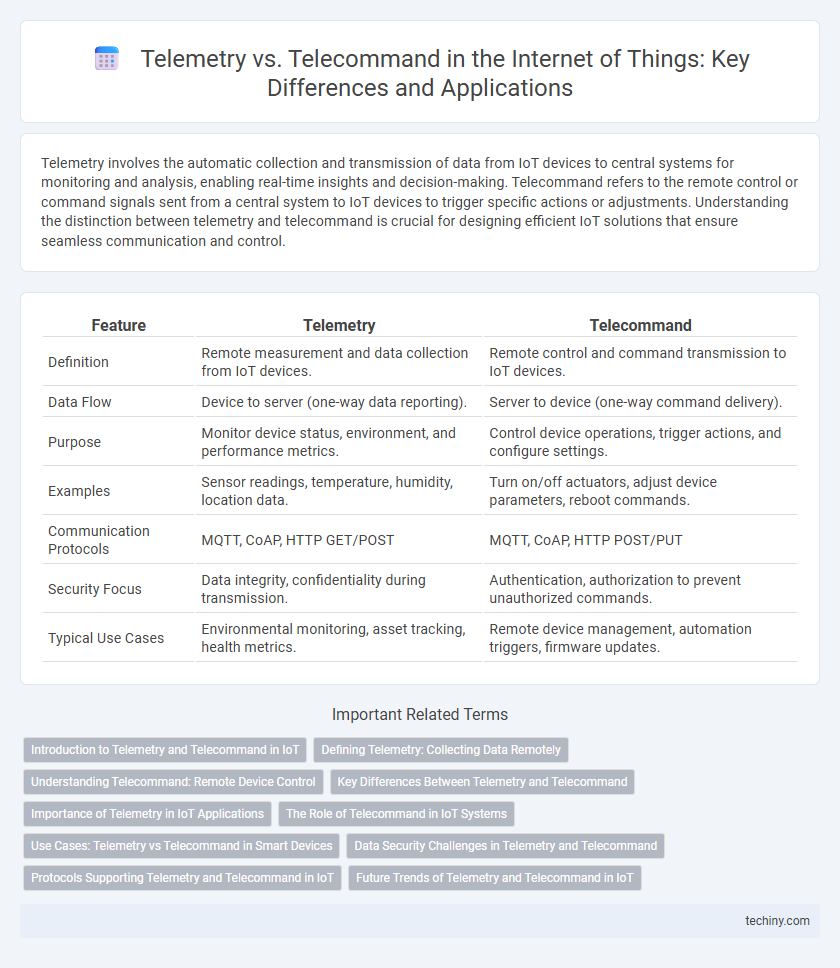Telemetry involves the automatic collection and transmission of data from IoT devices to central systems for monitoring and analysis, enabling real-time insights and decision-making. Telecommand refers to the remote control or command signals sent from a central system to IoT devices to trigger specific actions or adjustments. Understanding the distinction between telemetry and telecommand is crucial for designing efficient IoT solutions that ensure seamless communication and control.
Table of Comparison
| Feature | Telemetry | Telecommand |
|---|---|---|
| Definition | Remote measurement and data collection from IoT devices. | Remote control and command transmission to IoT devices. |
| Data Flow | Device to server (one-way data reporting). | Server to device (one-way command delivery). |
| Purpose | Monitor device status, environment, and performance metrics. | Control device operations, trigger actions, and configure settings. |
| Examples | Sensor readings, temperature, humidity, location data. | Turn on/off actuators, adjust device parameters, reboot commands. |
| Communication Protocols | MQTT, CoAP, HTTP GET/POST | MQTT, CoAP, HTTP POST/PUT |
| Security Focus | Data integrity, confidentiality during transmission. | Authentication, authorization to prevent unauthorized commands. |
| Typical Use Cases | Environmental monitoring, asset tracking, health metrics. | Remote device management, automation triggers, firmware updates. |
Introduction to Telemetry and Telecommand in IoT
Telemetry and telecommand are fundamental concepts in Internet of Things (IoT) systems, enabling remote monitoring and control of connected devices. Telemetry involves the automatic measurement and transmission of data from sensors to a central system for analysis, while telecommand refers to sending instructions from a control center to devices to perform specific actions. Efficient integration of telemetry and telecommand technologies enhances real-time decision-making and operational efficiency in IoT applications across industries such as smart cities, healthcare, and industrial automation.
Defining Telemetry: Collecting Data Remotely
Telemetry involves the automatic collection and transmission of data from remote IoT devices to centralized systems for monitoring and analysis. This technology enables real-time tracking of environmental conditions, equipment status, and operational metrics without physical intervention. Accurate telemetry data supports predictive maintenance, enhances system efficiency, and improves decision-making in IoT ecosystems.
Understanding Telecommand: Remote Device Control
Telecommand enables remote device control by sending commands from a central system to IoT devices, allowing actions such as switching on sensors or adjusting settings in real-time. This bidirectional communication differs from telemetry, which primarily involves the transmission of data from devices to the control system for monitoring purposes. Efficient telecommand protocols ensure secure and reliable execution of remote operations, essential for managing smart infrastructure and industrial IoT applications.
Key Differences Between Telemetry and Telecommand
Telemetry involves the automatic measurement and transmission of data from remote devices to a central system, enabling real-time monitoring of Internet of Things (IoT) sensors and assets. Telecommand, in contrast, refers to the sending of control signals or commands from a central system to remote IoT devices to perform specific actions or adjustments. The key differences lie in data flow direction--telemetry is data sent from devices to the controller, while telecommand is command signals sent from the controller to devices.
Importance of Telemetry in IoT Applications
Telemetry plays a crucial role in IoT applications by enabling real-time data collection and monitoring from connected devices, which empowers predictive maintenance and enhances operational efficiency. Through continuous transmission of sensor data, telemetry supports informed decision-making and immediate response to anomalies, ensuring system reliability and security. The integration of advanced telemetry protocols in IoT networks facilitates scalable, accurate, and low-latency communication, driving smarter automation and improved resource management.
The Role of Telecommand in IoT Systems
Telecommand plays a critical role in IoT systems by enabling remote control and management of connected devices through command signals, ensuring real-time response and operational efficiency. It facilitates automation by transmitting specific instructions from a central controller to IoT endpoints, such as smart sensors, actuators, and industrial machinery. Effective telecommand mechanisms improve system reliability, security, and scalability in complex IoT environments where timely device orchestration is essential.
Use Cases: Telemetry vs Telecommand in Smart Devices
Telemetry in smart devices enables real-time monitoring of sensor data such as temperature, humidity, and device status, facilitating predictive maintenance and energy management. Telecommand supports remote control actions, including adjusting settings on smart thermostats or initiating security protocols in connected home systems. Use cases highlight telemetry for data-driven insights, while telecommand empowers proactive device management and automation in IoT ecosystems.
Data Security Challenges in Telemetry and Telecommand
Telemetry and telecommand in the Internet of Things (IoT) face significant data security challenges, including unauthorized interception and data tampering risks during remote monitoring and control processes. Ensuring the confidentiality, integrity, and authentication of telemetry data streams and telecommand instructions requires robust encryption protocols, secure communication channels, and constant vulnerability assessments. The complexity of IoT networks amplifies exposure to cyber threats, necessitating advanced intrusion detection systems and secure key management to protect against malicious attacks and maintain system reliability.
Protocols Supporting Telemetry and Telecommand in IoT
Telemetry and telecommand in IoT rely on specialized protocols such as MQTT, CoAP, and AMQP to transmit sensor data and remote control instructions securely and efficiently. MQTT excels in lightweight, low-bandwidth telemetry data exchange with publish-subscribe architecture, while CoAP is optimized for constrained devices and supports simple RESTful telecommand operations. AMQP offers reliable message queuing and transaction support, enabling robust telemetry monitoring and telecommand execution in complex IoT environments.
Future Trends of Telemetry and Telecommand in IoT
Future trends in telemetry and telecommand within the Internet of Things emphasize increased integration of AI-driven analytics and edge computing to enhance real-time data processing and command execution. Advancements in 5G and beyond aim to reduce latency and improve the reliability of telemetry data transmission and telecommand responsiveness. Enhanced security protocols and blockchain technology are expected to play a crucial role in safeguarding communication channels between IoT devices and control systems.
Telemetry vs Telecommand Infographic

 techiny.com
techiny.com